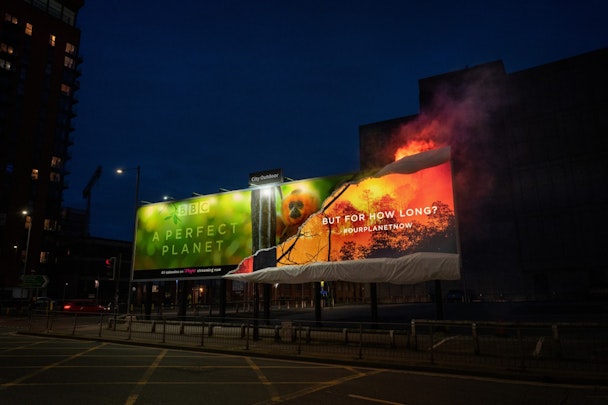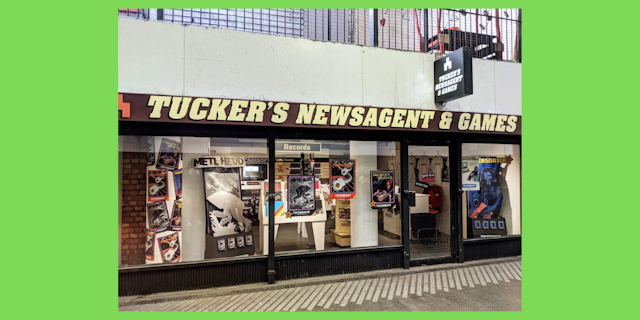
Advertisement

The BBC’s burning billboard for Sir David Attenborough’s Perfect Planet
Never has the battle for eyeballs been more epic. And with more choice than ever, entertainment companies are turning to increasingly inventive ways to get people to tune in to their programs. Here, The Drum rounds up some of our favorite TV show marketing from recent years.
“No longer are audiences OK with just being broadcast to,“ says Tom Jarvis, the chief exec of Wildnerness Agency, which he set up back in 2015 to understand how social was impacting the TV industry. “And it’s not an issue of shortening attention spans. Audiences today are the greatest curators of their own time and attention.”
With so much choice and control when it comes to their time and attention, today’s viewers present the entertainment companies desperate for their eyeballs with a altogether new challenge. How do they convince them to tune in to their show and not the myriad of others out there?
”When TV was dominated by big terrestrial TV providers, you used to be able to just advertise a particular show on a particular channel – like Big Brother on Channel 4,” says Sky Creative’s senior strategic planning manager Zoe D’Avignon. ”Like so many other categories, however, we’re seeing show advertising shift and expand.”
Now, she says, as the TV and content landscape explodes and fragments, so too does the way it is marketed. The digital era has not only impacted how we watch our favorite shows, but how we hear about them in the first place.
“There’s more platforms, media channels, partners, franchises, formats and new shows than ever before,“ says D’Avignon. “It’s much more complex and you need to earn people’s attention now more than ever when it comes to TV shows, which means having a deeper understanding of audiences.”
The BBC’s in-house creative agency BBC Creative has become undisputed champion of the unconventional TV marketing stunt in recent years, from its immersive Dracula billboard with bloody stakes to a burning billboard for Sir David Attenborough’s Perfect Planet.
“We aim for our campaigns to create conversation in culture and the main place those conversations happen is on social media,” Michael Lean tells us. The portfolio head of audiences at BBC Creative, he says its best social ideas don’t always look social at first. “The Dracula billboard doesn’t look social, but the true success of it was the traction it picked up online and in social media.”
Then there was its 2019 campaign announcing the return to the Beeb of broadcasting legend and comedy creation Alan Partridge, parachuted in as an emergency co-host of a faux daily magazine show.
Audiences at home first learned of the inept host filling in for ’clogged arteries’ John Baskell following the leak of an ’air-clearing’ email Partridge sent to 20,000+ legit BBC email addresses, hoping to ease his re-entry into the Beeb.
Everyone at the BBC just got this email from Alan Partridge.
“I ask every one of this email’s 20,000+ recipients to tune in tonight at 9.30pm on BBC One. Even if nobody else in the country does, we’re already hitting the kind of numbers my shows were getting on Sky Atlantic.” pic.twitter.com/bDMdbujBzA
— Scott Bryan (@scottygb) February 25, 2019
“I look at something like our campaign for Alan Partridge as a great example of making the most of an iconic character and what audiences already know about them,” says Lean.
“So the idea of an all-staff email about his return to the BBC was exactly what Alan would have done. Acting true to his character and using its heritage was our way of creating a campaign that led to audience reaction and press pick up. And that earned a load of attention and awareness around the new show without spending anything.”
Black Mirror became a cult classic when it hit screens in 2011, thanks to its razor-sharp dystopian satire that was uncomfortable to watch. To instill equal levels of intrigue and dread when it cam to marketing its third series in 2016, Martin Agency bought all the ad space Old Street Station, turning the silicon roundabout into a subversive experience.
Playing with the unnerving themes Black Mirror has become famous for, such as the threat of digital technology and surveillance, the takeover warned in bright lights that ‘The Worst Is Yet to Come’, while videos of people being watched unknowingly from their webcam played out (to add to the experience, Netflix ambassadors handed out webcam covers that would stop people being spied on from their laptops).
While the physical experience was for commuters, it wasn’t long before videos of the takeover spread across social. “Success for a TV show is people watching and people talking – that feeling that it’s everywhere – and our campaigns should be the engine behind that,” says D’Avignon. “You need to anticipate what will drive conversation about a show and focus on that in your comms. Advertising should be as compelling and conversation-worthy as the show itself.”

The Black Mirror team followed up the takeover when it launched interactive TV experience Bandersnatch. Once again commuters at Old Street were met with a curious subversive experience in 80s-themed pop-up Tucker’s Newsagent & Games. While the shop’s innards were filled with games and merchandise from Bandersnatch, a ‘be right back’ sign stopped people from entering.
D’Avignon says that when figuring out how best to advertise Sky’s TV shows, the team there looks at the relationship between the key themes or ingredients and the audience. “We’re asking ourselves what’s going to create an emotional connection, what will get people talking about a show? “That can be as simple as who’s in it or as big as the human truth that we’re all driven by a desire for power.”
She points to Sky Creative’s promo of the fantasy series A Discovery of Witches. “With a strong fan base already, we were able to tap into what people loved about the show and use that to power conversation and hype about it,” she explains. “The more people love a show the more they talk about it and we’ve got a role in understanding what drives their conversation and helping further fuel it. There’s an alchemy between telling new people about a returning show and speaking to fans to do the convincing for us.”
Back in 2017, Netflix was the first advertiser to use Snapchat’s 3D World Lenses format, which allowed Stranger Things fans to step into an ’upside down’ version of Joyce Byer’s famous living room.
“TV shows work with us to reach both incremental and new, hyper-engaged, Gen Z audiences that are found on Snapchat, push brand awareness to eventually lead audiences to their owned and operated platforms,” says Snap’s general manager Ed Couchman.“With lenses, TV shows use augmented reality to tell a further story, by bringing their audience into the action or simply to create buzz.”
Sticking with the Stranger Things theme, TV shows have traditionally partnered with fast-food joints like McDonald’s and Burger King. In 2019, Burger King released a promotional ’Upside-Down Whopper’ – a nod to the upside parallel dimension that exists in the retro sci-fi series.
More recently, TV shows have been finding ways to work with new kid on the block TikTok. “We’re supporting partners in TV across the industry that are looking to get more out of the platform, but we don’t have a prescribed one-size-fits-all approach that they need to follow,” says Sonia Gleeson, media and entertainment brand partnerships at TikTok.
“One way that TV brands can drive success is by interacting and engaging our community using TikTok features like ‘Branded Hashtag Challenges’ and by leaning into trends on the platform for a two-way experience.”
An example of this is Channel 4’s first-ever Branded Hashtag Challenge, which built on the popularity of hit show Taskmaster. “The challenge #taskmasterpiece encouraged users to create their own content and gave them a sense of being part of the story, turning them into authentic and powerful ambassadors. The challenge has amassed an incredible 3.8bn views.”
@taskmaster Have you joined the #Taskmasterpiece challenge yet? #fyp #taskmaster ♬ original sound - Taskmaster
Gleeson also points to ’organic trends’ on the platform built on the viral success of the TV show. She says that off the back of the hit Netflix regency drama Bridgerton, #BridgertonTheMusical clocked up more than 17.9m views, with TikTokers from all over the world collaborating to create songs and musical pieces to accompany moments from the show.
From late April until early May, The Drum is taking a deep dive into what’s in store for the small screen as we launch our Future of TV hub.